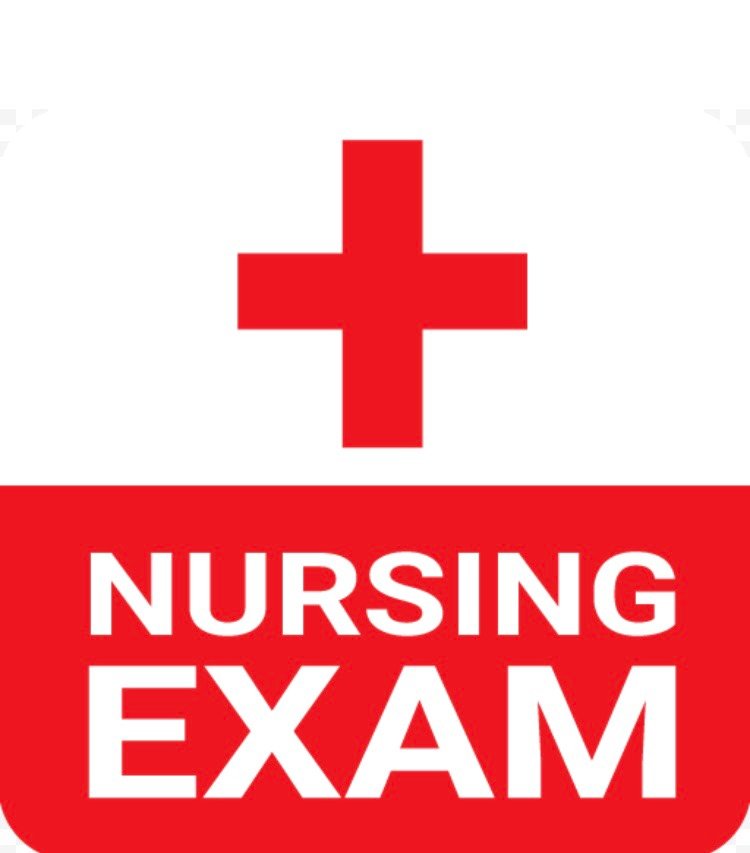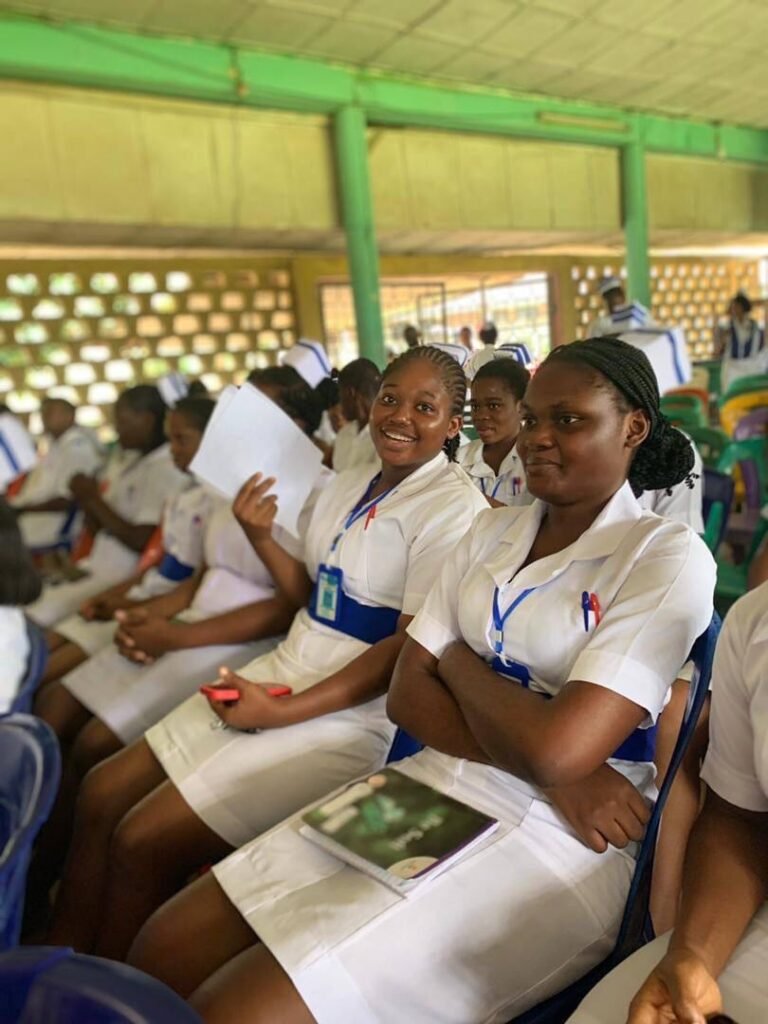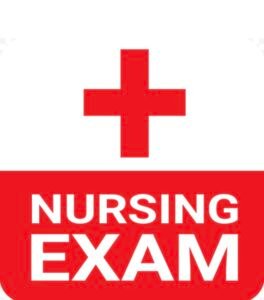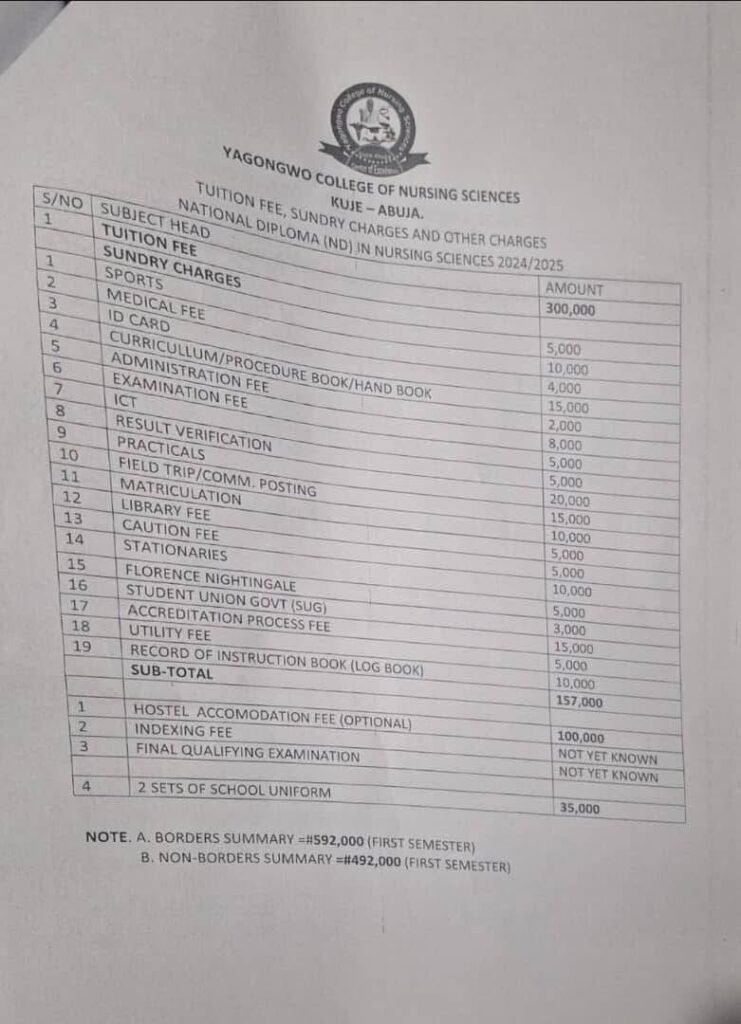The cut-off marks for nursing schools in Nigeria vary and depend on the institution, but the general cut-off mark for nursing admission in Nigeria has always been from around 200 to 290 out of a total score of 400 in the JAMB UTME for the majority of nursing schools in Nigeria.

What Are JAMB Cutoff Marks?
A JAMB cutoff mark is the minimum score you need to get in the JAMB exam to qualify for admission into a school or program. Each school sets its own cutoff mark based on the number of students applying, the available spaces, and the overall performance of students in that year’s exam.
For schools of nursing, the JAMB cutoff mark is important because it determines if you are eligible to proceed to the next stage of the admission process, such as writing the post-UTME or taking part in an interview.
Why Are JAMB Cutoff Marks Important for Schools of Nursing?
JAMB cutoff marks are important for several reasons. First, they help schools select the most qualified students. Nursing is a sensitive and demanding field, so schools want to admit students who are serious and ready for the challenges of the program.
Second, the cutoff marks help schools manage the number of applicants. Many students want to study nursing, but there are limited spaces available. Setting a cutoff mark allows schools to reduce the number of candidates they have to assess further.
Finally, cutoff marks give students a clear idea of what is expected of them. If you know the cutoff mark for your preferred school, you can work harder to meet or exceed it.
How Are JAMB Cutoff Marks Determined?
The process of setting JAMB cutoff marks involves several factors. Here are some of the most important ones:
1. Performance of Candidates
If students generally perform well in a particular year, the cutoff marks may be higher. On the other hand, if the performance is poor, the cutoff marks may be lower to accommodate more candidates.
2. Number of Applicants
When more students apply to a school, the competition becomes tougher, and the cutoff marks may increase. Schools with fewer applicants may set lower cutoff marks.
3. Capacity of the School
Each school of nursing has a specific number of students it can admit in a year. If a school has limited spaces, the cutoff mark may be higher to select only the best candidates.
4. Standards of the School
Some schools have a reputation for maintaining high academic standards. These schools may set higher cutoff marks to ensure they admit only the best-performing students.
General JAMB Cutoff Mark for Schools of Nursing in Nigeria
In most cases, the general JAMB cutoff mark for schools of nursing in Nigeria is between 160 and 200. However, this is just a guideline. Each school sets its specific cutoff mark based on the factors mentioned earlier.
It is important to note that meeting the general cutoff mark does not guarantee admission. You must also meet the specific requirements of the school you are applying to.
JAMB Cut-Off Mark for Nursing in 2025/2026
For those interested in applying for nursing in most universities in Nigeria, the JAMB cut-off mark is generally between 180 and 200. However, this range may vary depending on the institution and the level of competition. Nursing is a highly sought-after course, so some schools may set higher cut-off marks to select only the best-performing candidates.
Let us take a closer look at the expected JAMB cut-off marks for nursing programs in federal universities, state universities, private universities, and colleges of nursing sciences.
Federal Universities
Federal universities usually have higher cut-off marks for nursing due to the strong competition among candidates. The expected JAMB cut-off mark for nursing in federal universities typically ranges from 200 to 240 or even higher, depending on the university.
State Universities
State universities tend to have slightly lower cut-off marks compared to federal universities. The expected JAMB cut-off mark for nursing in most state universities is between 200 and 220. However, this depends on the competition level and the number of available spaces for nursing students.
Private Universities
Private universities offering nursing programs, such as Babcock University and Afe Babalola University, generally have more flexible admission requirements. Their expected JAMB cut-off marks for nursing programs typically start from 180 and above. Private universities often have less competition, making them a good option for students who meet the requirements.
College of Nursing Sciences
Colleges of Nursing Sciences offering degree programs usually set their JAMB cut-off marks between 180 and 200. These colleges are a great option for students who want to pursue nursing without necessarily attending a university.
It is important to note that meeting the JAMB cut-off mark does not automatically guarantee admission. Students must also meet other requirements, such as performing well in post-UTME exams or interviews conducted by the institutions.
By understanding these cut-off marks, students can better prepare and make informed decisions about their choice of institution for studying nursing in the 2025/2026 academic session.
The cut-off mark for nursing admission may be determined by factors such as the competitiveness of the program, the number of slots the school needs, and the overall performance of candidates in the entrance examination.
The highest score has been Ahmadu Bello University, Zaria, at 290, and the lowest cut-off mark for private universities like Madonna University, at 140. Here are some cut-off marks for nursing schools in Nigeria:
2025/2026 Jamb Cut-off Marks For Nursing in Private Universities:
- Atiba University Oyo admits candidates with 200
- Rhema University admits candidates with 160
- Madonna University Okija admits candidates with 180
- Redeemer’s University admits candidates with 180
- Lead City University Ibadan admits candidates with 180
- Igbinedion University Okada admits candidates with 180
- Bowen University admits candidates with 180
- Benson Idahosa University admits candidates with 180
- Adeleke University admits candidates with 160
- Babcock University admits candidates with 170
- Achievers University admits candidates with 160
- Al-Hikmah University admits candidates with 220
- Chrisland university admits candidates with 160
- Oduduwa University admits candidates with 160
- Clifford University admits candidates with 180
2025/2026 Jamb Cut-off Marks For Nursing in State Universities:
There are other universities whose cutoff marks are not presently included, until we have gathered enough information from these schools but for now, we have the following State universities:
- University of Medical Science Ondo State admits candidates with 200
- Imo state University Owerri admits candidates with 220
- Benue State University Markurdi admits candidates with 230
- The Ladoke Akintola University of Technology admits candidates with 260
- Kaduna State University admits candidates with 200
- Enugu State University admits candidates with 200
- Osun State University admits candidates with 200
- Abia State University admits candidates with 220
- Ambrose Alli University admits candidates with 220
- Delta State University admits candidates with 200
- Lagos State University admits candidates with 190
- Zamfara State University admits candidates with 200
- Olabisi Onabanjo University admits candidates with 250
- Ekiti State University admits candidates with 200
- Ebonyi State University admits candidate with 170
- River State University admits candidates with 220
Ebonyi State University:
APPROVED CUT-OFF MARK FOR 2025/2026 ADMISSION EXERCISE
Consequent to the JAMB directive in the policy meeting held on 18th July 2024, with regards to the guidelines, regulations, and timelines for the 2024/2025 admission exercise, the Management of the University has approved EBSU general minimum and programmes cut-off scores as follows: –
A. EBSU GENERAL CUT-OFF MARK – 140
B. PROGRAMMES MINIMUM SCORE
- FACULTY OF MEDICINE
- Medicine and surgery: Approved minimum score – 240
- Anatomy: Approved minimum score – 170
- Physiology: Approved minimum score – 170
2. FACULTY OF HEALTH SCIENCE AND TECHNOLOGY
- Nursing Science: Approved minimum score – 230
- Medical Laboratory Science: Approved minimum score – 200
- FACULTY OF LAW: Approved minimum score – 200
4. FACULTY OF MANAGEMENT SCIENCE
- Accountancy/Accounting: Approved minimum score – 160
- Other Management courses – 140
5. FACULTY OF SOCIAL SCIENCE AND HUMANITIES
- Mass Communication: Approved minimum score – 180
- Political Science: Approved minimum score – 150
- Economics: Approved minimum score – 150
- Other Social Sciences and Humanities Courses – 140
6. FACULTY OF SCIENCE
- Computer Science: Approved minimum score – 160
- Applied Microbiology: Approved minimum score – 150
- Other Science Courses – 140
- FACULTY OF AGRICULTURE AND NATURAL RESOURCES AND MANAGEMENT – 140
- FACULTY OF EDUCATION – 140
- FACULTY OF ENGINEERING AND ENVIRONMENTAL SCIENCES
- Chemical Engineering: Approved minimum score – 150
- Civil Engineering: Approved minimum score – 160
- Electrical and Electronics Engineering – 150
- Approved Minimum score for Environmental Sciences – 140
University Of Ibadan
Click the pdf below to download and access the Jamb cut-off mark for UI
Entry Requirements for Nursing in 2025/2026
Apart from meeting the JAMB cut-off mark, universities and colleges offering nursing programs have additional requirements that candidates must fulfill to be eligible for admission. Below is a breakdown of these requirements:
Post-UTME Screening
Candidates must take and perform well in the university’s post-UTME screening exam. This test is used to further assess the candidate’s knowledge and readiness for the nursing program. Each university sets its own post-UTME cutoff mark, which may vary based on performance and the number of applicants.
O’Level Requirements
Candidates must possess at least five credit passes in their O’Level results. The required subjects usually include:
• English Language
• Mathematics
• Biology
• Chemistry
• Physics
These credits must be obtained in not more than two sittings from recognized examination bodies such as WAEC, NECO, or NABTEB.
Catchment Areas and Quotas
Some federal and state universities may give preference to candidates from their catchment areas. This is in line with the federal character principle aimed at ensuring equal representation across different states. Additionally, universities may have quotas for male and female candidates in nursing programs.
Steps for Gaining Admission to Study Nursing
Here are the steps students can follow to secure admission into a nursing program for the 2025/2026 academic session:
Step 1. Register for JAMB
Ensure you register for the JAMB exam with the correct subject combination and select a nursing program as your preferred course of study.
Step 2. Prepare for JAMB
Study diligently using recommended textbooks, past questions, and other resources. Aim to score above the cutoff mark for your chosen institution.
Step 3. Take the JAMB Exam
Write the JAMB exam and ensure you achieve a score that meets or exceeds the cutoff mark for nursing in your preferred university.
Step 4. Apply for Post-UTME
After passing JAMB, register for the post-UTME screening of your chosen institution. Prepare well and perform excellently in the exam.
Step 5. Submit Required Documents
Ensure you provide all necessary documents, including your O’Level results, birth certificate, state of origin certificate, and other relevant credentials.
Step 6. Accept Admission
Once admitted, accept the offer on the JAMB CAPS portal and follow the institution’s instructions for registration and payment of fees.
2025/2026 Jamb Cut-off Marks For Nursing in Federal Universities:
There are other universities whose cutoff marks are not presently included, until we have gathered enough information from these schools but for now, we have the following federal universities:
- Bayero University Kano admits candidates with 220 and above
- The University of Ilorin admits candidates with 220 and above
- Obafemi Awolowo University admits candidates with 200 and above
- The University of Maiduguri admits candidates with 180 and above
- Federal University Birnin Kebbi admits candidates with 180 and above
- Federal University of Health Technology, Otukpo Benue State admits candidates with 180
- Federal University of Health Sciences, Azare, Bauchi State admits candidates with 160
- Federal University of Health Sciences, Ila Orangun, Osun State admits candidates with 160
- Federal University, Lafia, Nasarawa State admits candidates with 170
- Federal University, Lokoja, Kogi State admits candidates with 150
- Federal University, Kashere, Gombe State admits candidates with 150
- Federal University, Dutse, Jigawa State admits candidates with 150
- Federal University Gashua, Yobe admits candidates with 160
- Bayero University, Kano admits candidates with 180
- Abubakar Tafawa Balewa University, Bauchi admits candidates with 180
NB: There are other Schools which were not captured, but soon to be captured, whose Jamb cut off marks for 2025/2026 are out.
Frequently Asked Questions
What is the lowest JAMB cutoff mark for schools of nursing in Nigeria?
The lowest cutoff mark is usually around 160, but this varies by school.
Do all schools of nursing in Nigeria require JAMB?
No, some schools of nursing do not require JAMB. They conduct their own entrance exams.
Can I apply to multiple schools of nursing?
Yes, you can apply to multiple schools to increase your chances of admission.
What other exams do I need to pass for admission?
In addition to JAMB, many schools of nursing require you to pass their post-UTME, entrance exams, or interviews.
Can I gain admission into Nursing with jamb score of 170?
Actually, except for Schools of Nursing or Colleges of Nursing, I can assure you that, but you can’t get Nursing in both State and Federal Universities with the score.
which university can i study nursing with 180 in jamb
Honestly, there’s no university you can gain admission with that score. Why not try Private Schools of Nursing?
which university can i study nursing with 160 in nigeria?
Honestly, there’s no university you can study Nursing with 160 in Nigeria except Private Schools of Nursing.
can I study nursing with 200 in Jamb?
Yes, you can study Nursing with your Jamb score of 200. It depends on your university of choice.
which university has the lowest cut-off mark for nursing in nigeria?
Mostly State Universities tend to have low jamb cut-off marks.
list federal universities that offer nursing in nigeria and their cut-off mark?
I believe we answered this question in this article.
college of nursing cut off mark?
Colleges of Nursing release their cut-off marks during the sales of their admission forms every year. However, it depends on your score and your choice of College Of Nursing.
lowest cut off mark for nursing?
B.Sc Nursing cut-off marks are higher than RN, i.e. Schools of Nursing.
List Of Schools Of Nursing Selling Forms Now




Unilag Nursing Cut Off Marks For 2024/2025
21 Schools Of Nursing That Do Not Require Jamb For 2024/2025 Admissions
How To Print Your 2024/2025 Jamb Admission Letter For Various Institutions


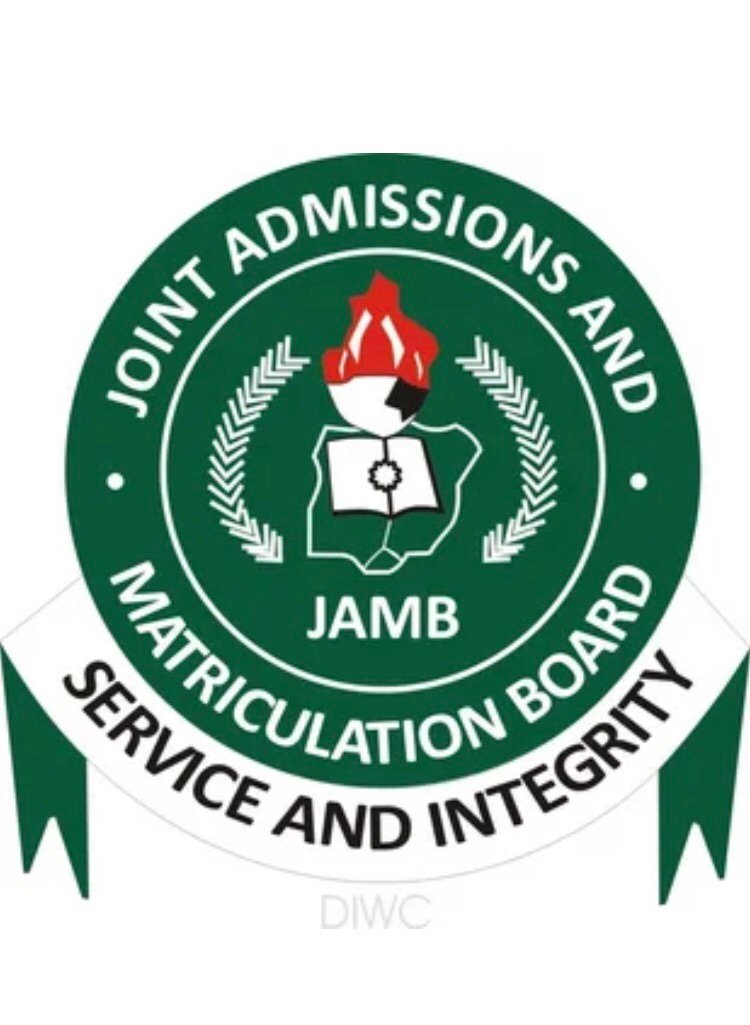
![7 Schools Of Nursing In Lagos Without Jamb [Updated 2025] 7 Schools Of Nursing In Lagos Without Jamb [Updated 2025]](https://nursinginfo.com.ng/wp-content/uploads/2024/10/img_1881-1.jpg)
